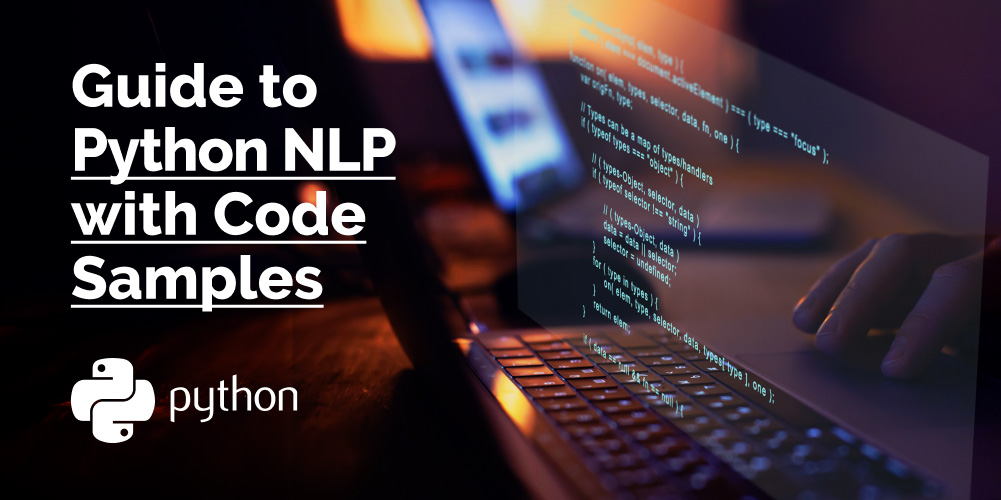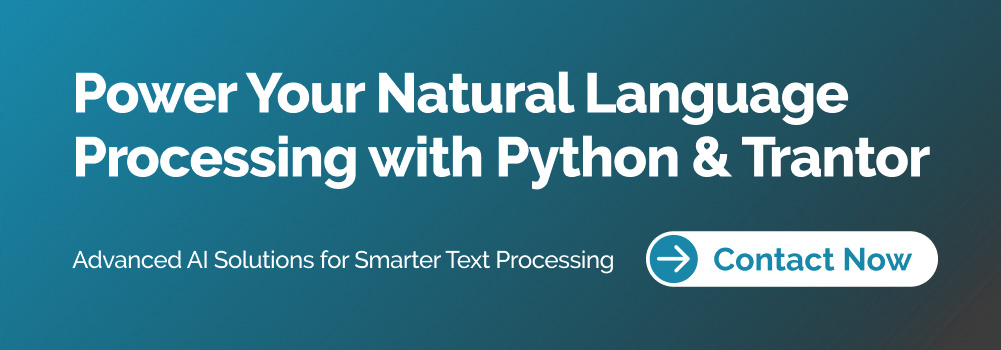Artificial Intelligence, zBlog
Natural Language Processing with Python: A Beginner’s Guide with Example Code and Output
atif | Updated: April 26, 2024

Introduction
In today’s data-driven world, the ability to extract meaningful insights from text data is becoming increasingly valuable. Natural Language Processing (NLP) is a branch of artificial intelligence that deals with the interaction between computers and humans using natural languages. NLP techniques enable machines to understand, interpret, and generate human language, making it possible to process and analyze vast amounts of textual data. Python, being a versatile and powerful programming language, has emerged as a popular choice for NLP tasks due to its rich ecosystem of libraries and frameworks. In this comprehensive guide, we’ll explore the fundamentals of Natural Language Processing with Python, covering essential concepts, libraries, and hands-on examples to kickstart your NLP journey.
1. Introduction to Natural Language Processing
Natural Language Processing (NLP) is a multidisciplinary field that combines computer science, linguistics, and machine learning. Its primary goal is to enable computers to understand and process human language in a natural and efficient manner. NLP tasks can be broadly categorized into two main areas:
- Natural Language Understanding (NLU): This involves comprehending and interpreting human language, such as speech recognition, text classification, sentiment analysis, and information extraction.
- Natural Language Generation (NLG): This involves generating human-readable text from structured data, such as text summarization, dialogue systems, and language translation.
NLP has numerous applications across various domains, including customer service (chatbots, virtual assistants), content analysis (sentiment analysis, topic modeling), information retrieval (search engines, question answering), and more.
2. Essential NLP Libraries in Python
Python offers a rich ecosystem of libraries and frameworks for NLP tasks. Here are some of the most popular and widely used libraries:
- NLTK (Natural Language Toolkit): One of the most comprehensive and widely used libraries for NLP in Python, NLTK provides a suite of tools and resources for text processing, including tokenization, stemming, lemmatization, part-of-speech tagging, and more.
- spaCy: A high-performance library for advanced NLP tasks, spaCy offers robust models for tokenization, part-of-speech tagging, named entity recognition, dependency parsing, and more. It is known for its speed and production-ready capabilities.
- Gensim: A robust topic modeling library, Gensim provides efficient implementations of algorithms like Latent Dirichlet Allocation (LDA), Word2Vec, and Doc2Vec for topic modeling, text similarity, and word embeddings.
- TextBlob: A user-friendly library built on top of NLTK and Pattern, TextBlob simplifies common NLP tasks like part-of-speech tagging, noun phrase extraction, sentiment analysis, and more.
- Hugging Face Transformers: A powerful library for state-of-the-art transfer learning models, such as BERT, GPT-2, and XLNet, enabling advanced NLP tasks like text generation, summarization, and question answering.
These libraries provide a solid foundation for building NLP applications in Python, offering a wide range of tools and functionalities to tackle various NLP tasks.
3. Data Preprocessing and Text Cleaning
Before diving into NLP techniques, it’s essential to preprocess and clean the text data to ensure accurate and reliable results. Here are some common preprocessing steps:
import re
import string
def preprocess_text (text):
# Convert to lowercase
text = text.lower()
# Remove URLs
text = re.sub ( r’http\s +’, ‘ ‘ , text)
# Remove HTML tags
text = re.sub ( r'<.*?>’ , ‘ ‘ , text)
# Remove punctuation
text = text.translate( str .maketrans ( ‘ ‘ , ‘ ‘ , string.punctuation ))
# Remove extra whitespace
text = ‘ ‘ .join (text . split() )
return text
In this example, we define a preprocess_text function that performs the following steps:
- Convert the text to lowercase for consistency.
- Remove URLs using regular expressions.
- Remove HTML tags using regular expressions.
- Remove punctuation characters using the string module.
- Remove extra whitespace by joining the words with a single space.
This function can be applied to your text data before proceeding with further NLP tasks.
4. Tokenization and Stemming/Lemmatization
Tokenization is the process of breaking down text into smaller units, such as words or sentences while stemming and lemmatization are techniques for reducing words to their base or root form.
from nltk.tokenize import word_tokenize, sent_tokenize
from nltk.stem import PorterStemmer, WordNetLemmatizer
# Tokenization
text = “This is a sample text for tokenization.”
tokens = word_tokenize(text)
print (tokens)
# Output: [‘This’, ‘is’, ‘a’, ‘sample’, ‘text’, ‘for’, ‘tokenization’, ‘.’]
sentences = sent_tokenize(text)
print(sentences)
# Output: [‘This is a sample text for tokenization.’]
# Stemming
stemmer = PorterStemmer()
stemmed_tokens = [stemmer.stem(token) for token in tokens]
print(stemmed_tokens)
# Output: [‘thi’, ‘is’, ‘a’, ‘sampl’, ‘text’, ‘for’, ‘token’, ‘.’]
# Lemmatization
lemmatizer = WordNetLemmatizer()
lemmatized_tokens = [lemmatizer.lemmatize(token) for token in tokens]
print (lemmatized_tokens)
# Output: [‘This’, ‘is’, ‘a’, ‘sample’, ‘text’, ‘for’, ‘tokenization’, ‘.’]
In this example, we use NLTK’s word_tokenize and sent_tokenize functions to tokenize the text into words and sentences, respectively. We then demonstrate stemming using the PorterStemmer and lemmatization using the WordNetLemmatizer.
5. Part-of-speech tagging and Named Entity Recognition
Part-of-speech (POS) tagging involves assigning a grammatical category (e.g., noun, verb, adjective) to each word in a text, while Named Entity Recognition (NER) aims to identify and classify named entities, such as person names, organizations, and locations.
import spacy
# Load the English language model
nlp = spacy.load(“en_core_web_sm”)
text = “Apple Inc. is an American multinational technology company headquartered in Cupertino, California.”
# Part-of-Speech Tagging
doc = nlp(text)
for token in doc:
print(token.text, token.pos_, token.tag_)
# Named Entity Recognition
print(“Named Entities:”)
for ent in doc.ents:
print(ent.text, ent.label_)
In this example, we use the spaCy library to perform POS tagging and NER. We load the English language model using spacy.load(“en_core_web_sm”) and create a Doc object by passing the text to the nlp object. We then iterate over the tokens in the Doc object and print the token text, part-of-speech tag, and detailed tag.
For Named Entity Recognition, we iterate over the ents (entities) property of the Doc object and print the entity text and label.
6. Sentiment Analysis
Sentiment analysis is the process of determining the sentiment (positive, negative, or neutral) expressed in a piece of text. This can be useful for understanding customer feedback, monitoring brand reputation, and more.
from textblob import TextBlob
text = “This product is amazing! I highly recommend it.”
blob = TextBlob(text)
sentiment = blob.sentiment.polarity
print(f”Sentiment Polarity: {sentiment}“)
# Output: Sentiment Polarity: 0.7
text = “The service was terrible, and the staff was rude.”
blob = TextBlob(text)
sentiment = blob.sentiment.polarity
print(f”Sentiment Polarity: {sentiment}”)
# Output: Sentiment Polarity: -0.6
In this example, we use the TextBlob library to perform sentiment analysis. We create a TextBlob object by passing the text, and then access the sentiment.polarity attribute, which returns a float value between -1 and 1, representing the sentiment of the text (-1 for negative, 0 for neutral, and 1 for positive sentiment). We can use this polarity score to classify the sentiment of the text based on predefined thresholds.
7. Topic Modeling and Document Clustering
Topic modeling is a technique used to discover abstract topics that occur in a collection of documents, while document clustering aims to group similar documents together based on their content.
import gensim
from gensim import corpora
# Sample data
documents = [
“This is a document about machine learning.”,
“Another document on artificial intelligence and deep learning.”,
“A third document discussing natural language processing.”,
“This document covers data mining and big data analytics.”
]
# Create a dictionary from the documents
dictionary = corpora.Dictionary(doc.split() for doc in documents)
# Create a document-term matrix
corpus = [dictionary.doc2bow(doc.split()) for doc in documents]
# Train the LDA model
num_topics = 2
lda_model = gensim.models.LdaMulticore(corpus=corpus, id2word=dictionary, num_topics=num_topics)
# Print the topics and their associated words
print(lda_model.print_topics())
# Compute document similarities
doc1 = documents[0]
doc2 = documents[2]
doc1_bow = dictionary.doc2bow(doc1.split())
doc2_bow = dictionary.doc2bow(doc2.split())
similarity = gensim.matutils.cossim(doc1_bow, doc2_bow)
print(f”Similarity between ‘{doc1}’ and ‘{doc2}’: {similarity}“)
In this example, we use the Gensim library for topic modeling and document clustering. We start by creating a list of sample documents and then build a dictionary and a document-term matrix from these documents.
We then train a Latent Dirichlet Allocation (LDA) model, specifying the number of topics we want to discover. The print_topics method displays the topics and their associated words.
Finally, we demonstrate document similarity by converting two documents into bag-of-words vectors and computing the cosine similarity between them using gensim.matutils.cossim.
These examples scratch the surface of Natural Language Processing with Python, but they provide a solid foundation for understanding and working with text data. As you delve deeper into NLP, you’ll encounter more advanced techniques and applications, such as text generation, machine translation, question answering, and more.

Additional Insights on Natural Language Processing with Python
Popular NLP Libraries in Python
Python offers several robust libraries for natural language processing (NLP), including NLTK, spaCy, Gensim, and scikit-learn. These libraries provide essential tools for text preprocessing, sentiment analysis, topic modeling, and named entity recognition. Whether you’re working with structured or unstructured data, these tools make it easier to build NLP programs in Python efficiently.
Approaches to NLP in Python
There are two primary approaches to NLP in Python: rule-based and statistical methods. While rule-based approaches rely on predefined linguistic rules, statistical methods leverage machine learning to analyze large datasets. Due to their scalability and adaptability, statistical methods are more commonly used in modern applications of natural language processing in Python.
The Role of Data in NLP
Statistical NLP models require vast amounts of data to perform effectively. Training a high-accuracy NLP model often involves processing millions of text samples. Without large datasets, machine learning models struggle to generalize well, making it crucial to source diverse and extensive data for tasks such as text classification and language modeling in NLP using Python.
Real-World Applications of NLP
NLP applications in Python span multiple domains, from customer service chatbots to automated text generation. Some key applications include:
- Machine Translation: Converting text from one language to another using Python NLP.
- Text Summarization: Extracting key points from lengthy articles.
- Sentiment Analysis: Evaluating the emotional tone of user reviews and social media posts.
- Question Answering Systems: Building intelligent assistants that retrieve answers from large datasets.
Evaluating NLP Model Performance
To ensure that NLP models perform optimally, various evaluation metrics are used. Common classification metrics include accuracy, precision, recall, and F1 score. For regression-based NLP tasks like predicting review scores, metrics such as mean absolute error (MAE) are frequently applied.
Sentiment Analysis Trends
Sentiment analysis, a crucial NLP application, has revealed interesting trends in various studies. For instance, research on news headlines found that approximately 70% of articles are classified as neutral, 18% as positive, and 11% as negative. These insights highlight the importance of refining NLP code to enhance sentiment classification accuracy.
Word Frequency Analysis in NLP
In text analysis, stopwords such as “to,” “in,” and “for” appear frequently across datasets. However, certain topics, such as global events or political discussions, may be dominated by specific words like “US,” “Iraq,” and “war.” NLP programs in Python often incorporate stopword removal and word frequency analysis to enhance text comprehension.
Understanding N-grams in NLP
N-grams, particularly bigrams and trigrams, play a crucial role in language modeling and text prediction. For example, in news headlines related to global conflicts, phrases like “anti-war” and “killed in” are common bigrams. Natural language processing with Python (NLP with Python) enables users to extract these meaningful word patterns for enhanced text analysis.
Topic Modeling with Python
One of the most widely used techniques for topic modeling in NLP is Latent Dirichlet Allocation (LDA). LDA helps uncover hidden themes in large text corpora, making it invaluable for applications such as content recommendation and automated categorization in natural language processing Python projects.

Industry Applications of NLP
The growing adoption of NLP across industries underscores its versatility. Some notable use cases include:
- Customer Service: AI-powered chatbots and virtual assistants streamline customer interactions.
- Marketing: Sentiment analysis tools evaluate customer feedback to improve marketing strategies.
- Healthcare: Clinical text analysis extracts valuable insights from medical records.
By leveraging NLP in Python, businesses can enhance automation, gain actionable insights, and improve user engagement. Whether through Python NLP models or innovative NLP programs in Python, the field continues to expand, offering transformative solutions across multiple domains.
FAQs: Natural Language Processing with Python
1. What is NLP with Python?
Natural Language Processing with Python (NLP with Python) refers to using Python libraries and tools to process, analyze, and understand human language. Python offers powerful libraries like NLTK, spaCy, and Transformers for various NLP tasks, including text classification, sentiment analysis, and machine translation.
2. Which Python library is used for Natural Language Processing (NLP) tasks?
Several Python libraries are used for NLP tasks, including:
- NLTK (Natural Language Toolkit) – Best for academic and research-based NLP.
- spaCy – Efficient and production-ready NLP library.
- Transformers (by Hugging Face) – Used for deep learning NLP models like BERT and GPT.
- TextBlob – Simplified NLP for beginners.
- Gensim – Best for topic modeling and word embeddings.
3. What are the 4 types of NLP?
The four main types of NLP are:
- Syntax Processing – Parsing, POS tagging, and sentence structure analysis.
- Semantics Processing – Named entity recognition (NER), word sense disambiguation.
- Speech Processing – Speech-to-text, text-to-speech conversion.
- Pragmatics and Discourse Processing – Context understanding and intent recognition.
4. What are the 7 layers of NLP?
The seven layers of NLP include:
- Phonology – Understanding sound patterns.
- Morphology – Studying word formation and structure.
- Lexical Analysis – Identifying words and their meanings.
- Syntax Analysis – Understanding grammatical structure.
- Semantics Analysis – Extracting the meaning of words and sentences.
- Pragmatics – Understanding language in context.
- Discourse Analysis – Interpreting longer texts and conversations.
5. What are the 5 steps in NLP?
The five main steps in NLP are:
- Tokenization – Splitting text into words or sentences.
- Stopword Removal – Eliminating common words (e.g., “is,” “the”).
- Stemming and Lemmatization – Reducing words to their base forms.
- Part-of-Speech (POS) Tagging – Identifying nouns, verbs, adjectives, etc.
- Named Entity Recognition (NER) – Extracting entities like names, locations, and dates.
6. How do I start with NLP in Python?
To start NLP in Python:
- Install a library like spaCy, NLTK, or Transformers.
- Preprocess text (tokenization, stopword removal, stemming).
- Use POS tagging and Named Entity Recognition (NER).
- Apply machine learning models for text classification, sentiment analysis, etc.
7. What are some Natural Language Processing examples?
Examples of NLP applications include:
- Chatbots (e.g., customer support bots).
- Speech-to-text conversion (e.g., Google Voice, Siri).
- Sentiment Analysis (e.g., analyzing social media comments).
- Text Summarization (e.g., summarizing long news articles).
- Language Translation (e.g., Google Translate).
8. What is the difference between NLP and Machine Learning?
- NLP focuses on understanding and processing human language.
- Machine Learning (ML) involves training models using data, which can be used in NLP tasks like text classification and speech recognition.
9. What is the best Python NLP library for beginners?
For beginners, NLTK and TextBlob are great choices as they are easy to learn and come with built-in datasets. spaCy is also beginner-friendly but better suited for production applications.
10. Can NLP be used for sentiment analysis?
Yes! NLP is widely used for sentiment analysis, which helps determine whether a piece of text is positive, negative, or neutral. Libraries like TextBlob, VADER, and Transformers are commonly used for this task.
Conclusion
Natural Language Processing with Python (NLP with Python) is a powerful field that enables machines to understand and interact with human language. By leveraging Python’s rich ecosystem of NLP libraries, you can tackle a wide range of tasks, from text preprocessing and tokenization to sentiment analysis, topic modeling, and document clustering.
This beginner’s guide has provided a comprehensive overview of Natural Language Processing with Python (NLP with Python), covering essential concepts, libraries, and hands-on examples. Whether you’re interested in building chatbots, analyzing customer feedback, or exploring new frontiers in language processing, the knowledge and skills gained from this guide will serve as a strong foundation for your NLP journey.
Trantor is a pioneering company at the forefront of Natural Language Processing (NLP) and Artificial Intelligence (AI) solutions. With a team of highly skilled data scientists, linguists, and software engineers, Trantor is dedicated to developing innovative NLP technologies that empower businesses to unlock the full potential of their textual data.
Leveraging cutting-edge machine learning algorithms and state-of-the-art language models, Trantor offers a comprehensive suite of NLP services, including sentiment analysis, text classification, named entity recognition, information extraction, and more. These solutions are designed to provide invaluable insights and automate complex language-related tasks, enabling organizations to make data-driven decisions and enhance operational efficiency.
Trantor’s commitment to delivering high-quality, tailored solutions sets them apart in the NLP landscape. By combining deep domain expertise with advanced technological capabilities, Trantor ensures that its clients receive customized NLP solutions that address their specific needs and drive meaningful business impact.




